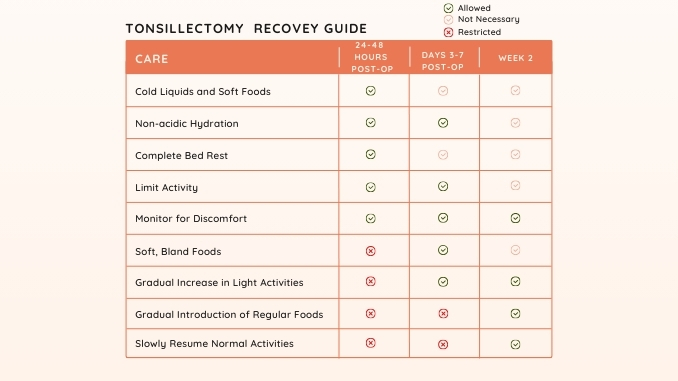A tonsillectomy is a medical procedure that removes the tonsils, which are lymphoid tissues located at the back of the throat. This procedure is commonly performed to treat chronic or recurrent tonsillitis, obstructive sleep apnea, or other tonsil-related issues. Understanding the process of tonsillectomy recovery in adults is crucial for a smoother healing experience, as recovery can be more challenging compared to children due to increased discomfort and a longer healing period.
Significant numbers of individuals [1] of various ages undergo this surgery. In the U.S. alone, 102,000 tonsillectomy procedures are performed annually.
A tonsillectomy is when the tonsils are surgically removed, usually while you’re under general anesthesia. Surgeons can use different methods, like cutting with a cold knife, using electrocautery, or opting for newer techniques like collation.
Coblation is a technique used in tonsil removal surgery where doctors use gentle radio waves to dissolve the tonsil tissue. It works at a lower temperature than other methods, which means it can cause less pain and swelling after the surgery.
Tonsillectomy is usually an outpatient procedure. The whole procedure typically lasts about 30 to 60 minutes. Afterward, you’ll likely have a sore throat, swelling, and trouble swallowing.
Among adults, a tonsillectomy is commonly performed to treat the following:
- Chronic Infection or Recurrent Tonsillitis: Frequent inflammation and bacterial infections of the tonsils, causing sore throats and difficulty swallowing. Compared to pediatric cases [2], this remains the most common reason for Tonsillectomy. Frequent tonsillitis is generally defined as:
- At least seven episodes in the past year
- At least five episodes a year in the past two years
- At least 3 episodes a year in the past three years
- Obstructive Sleep Apnea: A condition in which enlarged tonsils obstruct the airway during sleep, causing breathing interruptions and reduced sleep quality.
- Other Tonsil-Related Issues: Includes abscesses, tonsil stones, or tumors, which can cause pain, infection, or difficulty swallowing.
Tonsillectomy recovery in adults generally takes one to two weeks, with lots of rest, pain management, and eating soft foods to help you heal.
In this article, we will focus on the recommended recovery regimen for adults, navigating through proper postoperative care, rest, and diet.
Post-Surgery Management

Immediately after a tonsillectomy and within the first and leading up to the second week, you can expect to experience the following:
- Throat Pain: Significant soreness and discomfort in the throat, making swallowing difficult.
- Swelling: Swelling in the throat and potentially the uvula, causing a feeling of tightness.
- Difficulty Swallowing: Pain and discomfort when eating or drinking, often requiring a soft food diet.
- Ear Pain: Referred pain in the ears may occur days after surgery due to shared nerve pathways.
- Bleeding: Minor bleeding from the surgical site is normal, but significant or persistent bleeding with bright red blood requires medical attention.
- Bad Breath: Due to the healing process and presence of scabs in the throat. Gargling with a mild salt water solution can help improve bad breath due to its antibacterial properties. Additionally, gargling with salt water may help prevent the progression of respiratory tract infections.
- Fatigue: General tiredness and the need for extended rest.
- Changes in Voice: Temporary changes in voice quality or nasal sound.
- Dehydration Risk: Increased risk of dehydration if fluid intake is insufficient due to pain.
Recommended Care

1. Pain Management
Take prescribed pain medication regularly. Over-the-counter pain medicine options like acetaminophen or ibuprofen can also be used when directed by your doctor.
Disclaimer: If you experience severe pain that is not managed by prescribed or over-the-counter pain medications, contact your healthcare provider speedily for further evaluation and appropriate treatment.
2. Hydration and Diet
Drink plenty of fluids to stay hydrated, such as water, ice chips, and clear broths. Avoid acidic or citrus beverages that may irritate the throat. Eat soft, bland foods like applesauce, mashed potatoes, pudding, and ice cream. Avoid spicy, crunchy, or hot foods that can irritate the throat.
3. Rest

Get plenty of rest and avoid strenuous activities. It’s important to allow your body to heal for tonsillectomy recovery for adults.
4. Avoid Irritants
Stay away from smoke, fumes, and other irritants that can cause throat discomfort.
5. Monitor for Complications
Watch for signs of excessive bleeding, high fever, or dehydration, and contact your doctor if any of these occur.
6. Follow-Up Appointments
Attend all follow-up appointments with your doctor to ensure you heal properly and to discuss any concerns about tonsillectomy recovery in adults.
Recommended Diet and Rest After Tonsillectomy

Following a proper diet and rest are crucial for a smooth tonsillectomy recovery in adults. Here are comprehensive recommendations for both, with rationale integrated:
Initial 24-48 Hours
- Cold Liquids and Soft Foods: Due to pain in post-operation, it is advised to start the diet with cold or room temperature liquids like water, ice chips, and clear broths. Cold foods like ice cream, popsicles, and smoothies help reduce swelling and numb the throat, easing pain and inflammation.
- Avoid Acidic and Citrus Beverages: These can irritate the healing tissues and cause severe throat pain. Stick to non-acidic drinks like milk, water, and non-citrus juices to prevent further irritation.
- Complete Bed Rest: Stay in bed or rest in a comfortable position for most of the day. This ensures your body can use its energy for healing rather than physical exertion, reducing the risk of complications.
- Limit Activity: Avoid any physical activity, including walking around too much or engaging in light exercise. Keeping movement minimal helps prevent strain on the throat and surgical site, reducing the risk of bleeding.
Days 3-7
- Soft, Bland Foods: While studies suggest [3] a regular diet doesn’t cause much difference in pain or bleeding after tonsillectomy compared to a restrictive one, this recommendation prioritizes preventing throat irritation from certain ingredients.
Hence, it is safer to gradually introduce soft, bland foods that are easy to swallow and gentle on the throat, such as smoothies, mashed potatoes, oatmeal, yogurt, pudding, scrambled eggs, and cream-based pasta. These foods are less likely to irritate the surgical site, making eating more comfortable. - Hydration: Continue drinking plenty of fluids to stay hydrated. Proper hydration is crucial for healing and helps prevent dehydration, which can be a risk due to decreased fluid intake from throat pain.
- Avoid Spicy, Crunchy, or Hard Foods: Foods like chips, crackers, nuts, and spicy dishes can irritate the throat and cause pain or bleeding, hindering the healing process.
- Gradual Increase in Light Activities: Begin to move around gently, such as walking short distances within your home. This helps maintain circulation without putting too much strain on your body.
- Avoid Strenuous Activities: Continue to avoid strenuous activities like heavy lifting, running, or intense exercise. These can increase blood pressure and the risk of bleeding, which can disrupt the healing process.
Week 2
- Gradual Introduction of Regular Foods: As healing progresses and pain decreases, slowly reintroduce more solid foods into your diet. Start with soft fruits, steamed vegetables, and tender meats. This helps ensure you get the necessary nutrients without causing additional discomfort.
- Monitor for Discomfort: Pay attention to how your throat feels with each new food and adjust your diet accordingly. If a particular food causes discomfort, wait a few more days before trying it again, ensuring the healing process is not disrupted.
- Slowly Resume Normal Activities: Gradually return to your normal routine, but listen to your body and avoid pushing yourself too hard. Start with low-impact activities and increase intensity as you feel comfortable, allowing your body to heal at a comfortable pace.
- Full Activity Restrictions: Refrain from any activities that involve significant physical exertion or contact sports for at least two weeks. This ensures complete healing of the surgical site and prevents complications from overexertion.
By following these combined diet and rest recommendations, you can support your body’s healing process, minimize discomfort, and reduce the risk of postoperative complications.
Long-Term Impact of Tonsillectomy

1. Immune System
- Reduced Tonsillar Defense: Tonsils are part of the immune system and help fight infections. Their removal might slightly reduce the body’s ability to fight certain infections, though other lymphoid tissues can compensate.
- Overall Immune Function: Generally, there is minimal long-term impact on the immune system as other immune tissues adapt.
2. Respiratory Health
- Improved Sleep Quality: For those with obstructive sleep apnea, removing the tonsils can significantly improve breathing during sleep, enhancing overall sleep quality and reducing associated health risks.
- Reduced Throat Infections: Individuals prone to chronic tonsillitis may experience fewer throat infections, leading to better respiratory health over time.
3. Metabolic and Weight Changes
- Potential Weight Gain: Some studies suggest a link between tonsillectomy and weight gain, particularly in children. This might be due to changes in eating habits and metabolic factors post-surgery.
4. Swallowing

- Changes in Swallowing: Some people might notice subtle long-term changes in swallowing or throat sensation, although these generally adapt over time.
5. Psychological and Quality Life
- Reduced Anxiety: For those who have experienced frequent infections and related health concerns, a tonsillectomy can reduce anxiety and improve quality of life by eliminating the root cause of these issues.
- Improved Well-being: Enhanced sleep quality and fewer infections contribute to better overall well-being and life satisfaction.
6. Respiratory Infections
- Potential Increase in Other Infections: While tonsillectomies reduce the occurrence of tonsillitis, they may potentially increase susceptibility to other upper respiratory infections due to the removal of the throat’s first line of immune defense.
Disclaimer: This information is for educational purposes only and is not a substitute for professional medical advice. Always consult your doctor for medical guidance and treatment. If you experience severe symptoms or complications, contact your healthcare provider immediately.
Conclusion
While the recovery process is not easy and requires careful management of pain, hydration, diet, and rest, following these guidelines can support a smoother healing journey. A tonsillectomy can provide significant benefits for adults suffering from chronic tonsillitis, obstructive sleep apnea, and other tonsil-related issues.
However, it is important to recognize that the procedure also poses potential long-term risks. These can include slight reductions in immune function, changes in voice quality, and the possibility of increased susceptibility to other respiratory infections.
Therefore, it is crucial for patients to stay informed about these risks and actively manage all areas of their health to minimize potential complications. This includes maintaining a healthy lifestyle, staying vigilant about any new symptoms, and regularly consulting with healthcare providers for ongoing care and advice about tonsillectomy recovery in adults.
By doing so, patients can enjoy the benefits of the procedure while mitigating its risks, ensuring better overall health and well-being in the long run.
Find out how to get rid of dangerous inflammation before it ruins your health in this informative master guide. Check out this Master Guide to Inflammation now!


Rick Kaselj MS, is a leading kinesiologist and injury specialist as well as co-creator of the best-selling Unlock Your Hip Flexors program. Rick creates exercise programs that help people heal injuries and eliminate pain, so they can go back to living a full, active, healthy life.



